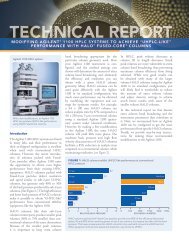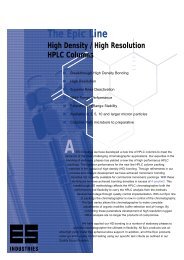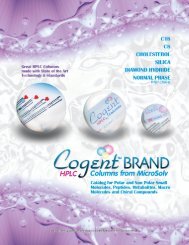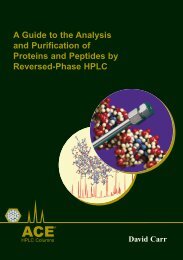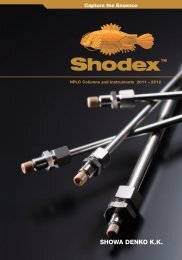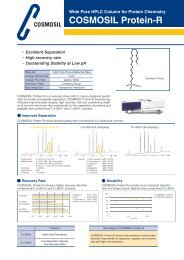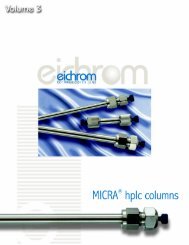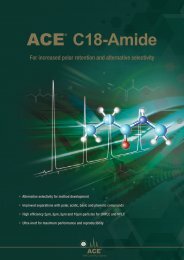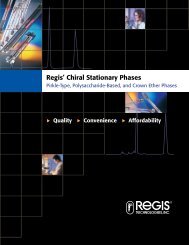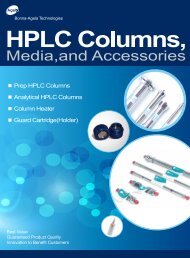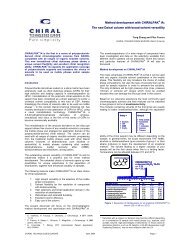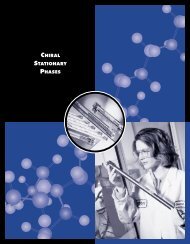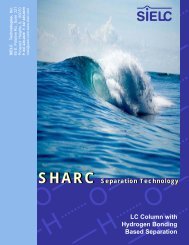HALO Penta-HILIC Columns - Hplc.eu
HALO Penta-HILIC Columns - Hplc.eu
HALO Penta-HILIC Columns - Hplc.eu
- No tags were found...
You also want an ePaper? Increase the reach of your titles
YUMPU automatically turns print PDFs into web optimized ePapers that Google loves.
penta-hilicUHPLC COLUMNS
• Highly retentive, proprietary penta-hydroxy-ligandpenta-hilic• Excellent peak shape for polar compounds with a variety offunctional groups:• acids, bases, zwitterions• strong and weak acids, bases• peptides, sugars, n<strong>eu</strong>cleoside bases, nucleosides,nucleotides, and derivatives• Compatible with all typical <strong>HILIC</strong> operating conditions• Fast equilibration of the column, especially useful for gradientseparations• High stability under acidic and mildly basicconditions of operation• Very high efficiency packed columns (>200,000 plates permeter)• Utilizes Halo Fused-Core® particles with 2.7 µm particlediameter and 0.5 µm thick porous layer, for maximum performanceat any flow rate• Available in a broad range of column dimensions for a varietyof analytical applications• Moderate back pressure places less stress on instrumentparts and permits these UHPLC columns to be used withconventional HPLC equipment.• The use of 2 μm porosity column inlet frits reduces theinconvenience caused by pressure increases from plugged fitsand makes <strong>HALO</strong> columns more forgiving and easier to usethan columns packed with sub-2 μm particles.
<strong>HALO</strong> Fused-Core particle technology facilitates ultra-fast, high resolution“UHPLC” separations with either UHPLC or conventional HPLC equipment.Now, <strong>HALO</strong> <strong>Penta</strong>-<strong>HILIC</strong> columns join <strong>HALO</strong> C18, C8, RP-Amide,ES-CN, Phenyl-Hexyl, PFP, Peptide ES-C18 and the standard silica <strong>HILIC</strong>phase to offer a wide range of powerful selectivity choices to accomplish themost demanding separations. <strong>HALO</strong> <strong>Penta</strong>-<strong>HILIC</strong> is particularly well suitedfor the separation of highly polar compounds that are poorly retained undertypical reverse phase conditions. In addition, <strong>HALO</strong> <strong>Penta</strong>-<strong>HILIC</strong> columnsare highly recommended for LC-MS application due to their compatibilitywith MS-friendly mobile phases and exhibit extremely low bleed.TABLE 1: Features of the various chemistries that AMT has developed for <strong>HILIC</strong>:Product Features Analyte Considerations Mobile Phase Considerations<strong>HALO</strong> <strong>HILIC</strong> polar silanols highest base retention withgood peak shape, someanionic characterHalo <strong>Penta</strong>-<strong>HILIC</strong> polar C-OH high acid, base, zwitterionretention, with good shapen<strong>eu</strong>tral characterHalo PFP polar C-F unique selectivity, high retentionfor acids, n<strong>eu</strong>trals, somecationic charactertypical <strong>HILIC</strong>, higher ionicstrength at n<strong>eu</strong>tral pH, avoidpH >8, highly stable low pHtypical <strong>HILIC</strong>, forgiving forionic strength, avoid pH 8, pH
Mechanism of SeparationRetention in <strong>HILIC</strong> is not well-understood, but appears to be a combinationof hydrophilic interaction, ion-exchange and some reversed-phase retention.The aqueous layer that forms on the polar surface of the <strong>Penta</strong>-<strong>HILIC</strong> particlespromotes interaction with polar solutes. Retention in <strong>HILIC</strong> mode as afunction of the mobile phase is just opposite from that in reversed phase. Thestrongest mobile phase has a high percentage of water and the weakest has ahigh percentage of organic solvent. For gradient separations, the initial mobilephase has a high percentage of organic solvent and the gradient is formed byincreasing percentage of the aqueous component. The greatest retention forbasic and acidic analytes is found when using more than about 70% organic(e.g., acetonitrile) in acidic mobile phases. Since high organic concentrationsare used in the mobile phases, <strong>HILIC</strong> is especially favorable for separationsusing mass spectrometry (MS) detection.Due to the highly polar mobile phases used in <strong>HILIC</strong>, both acidic and basiccompounds often exhibit highly symmetrical peak shapes, often superior tothose obtained in reversed phase. In addition, sample loading effects often aremore favorable for <strong>HILIC</strong> . When optimized, <strong>HALO</strong> <strong>Penta</strong>-<strong>HILIC</strong> columnsshow efficiency that is competitive with results obtained with reversed phase.Although increased column operating temperatures can improve efficiencyand peak shape in reversed-phase chromatography, temperatures above 60ºCgenerally are not recommended with <strong>HILIC</strong>.Mobile phase solventsAcetonitrile is commonly used as the weak mobile phase component in<strong>HILIC</strong> separations. With this solvent, 95% is typically the upper limit and60% the lower limit for adequate retention. At least 5% of the mobile phaseshould be a highly polar solvent such as water or methanol. If buffers are used,water is preferred for improved buffer solubility. As in reversed-phase mode,the organic solvent type can be varied to change retention and separation selectivity.Solvent strength (from weakest to strongest) for the <strong>Penta</strong>-<strong>HILIC</strong> phasegenerally is tetrahydrofuran < acetone < acetonitrile < isopropanol < ethanol< methanol < water.When using a gradient to scout for optimum mobile phase conditions, 90 -95% acetonitrile is suggested as the initial solvent composition and 50 - 60%acetonitrile as the ending composition. The resulting elution characteristicscan be used to estimate the appropriate mobile phase composition for isocraticelution in much the same way as for reversed phase. To further increase retentionin <strong>HILIC</strong>, replacing some of the water in the mobile phase with anotherpolar solvent such as methanol or isopropanol is sometimes effective.Mobile phase buffersFor optimum column efficiency and reproducibility, buffers in the range of10 - 20 mM concentration or additives in the 0.5% range can be used in themobile phase. Phosphate buffers are not recommended because of their poorsolubility in high organic mobile phases and incompatibility with MS detection.Additives such as formic acid, trifluoroacetic acid and phosphoric acidat concentrations up to about 1% can be used in the mobile phase. Volatileammonium formate/formic acid buffers up to a final concentration of about20 mM and pH 3 are especially effective for separating both basic and acidiccompounds when interfacing the liquid chromatograph to a mass spectrometer.Acetonitrile/formate mobile phases seem to be a good starting point formany separations of both basic and acidic compounds. Ammonium acetate atpH ~5 has also been used at concentrations of 5 - 20 mM, but is generally lesseffective for separating stronger basic and acidic compounds. Buffers or additivesabove pH 9 usually are not recommended because they may enhance theslow dissolution of the silica support.Sample conditionsAs with reversed phase, the solvent used to inject the sample is an importantconsideration with <strong>Penta</strong>-<strong>HILIC</strong>. As in reversed-phase, the sample solventshould, as closely as possible, resemble the strength and type of the mobilephase. The sample solvent can contain a higher amount of organic than themobile phase, but if it contains a higher amount of polar solvent (e.g., water),peak shape will be compromised, especially for early-eluting compounds.A mixture of 75:25 (v/v) acetonitrile/methanol is sometimes useful as thesample solvent, if for some reason it is not possible to inject the sample dissolvedin the mobile phase.Very strong solvents such as dimethylformamide or dimethylsulfoxide willusually result in poor peak shapes and are not recommended. These solventswill generally have to be diluted with a weaker solvent such as acetonitrilebefore satisfactory peak shape can be obtained.
Figure 3: Separation of Antiulcer DrugsFigure 4: Separation of Beta Blocker DrugsTEST CONDITIONS:Column: 4.6 x 100 mm, <strong>HALO</strong> <strong>Penta</strong>-<strong>HILIC</strong>Part Number: 92814-605Mobile Phase: 10/90: A/BA= 0.04 M Ammonium formate, pH=3.0 (adj.)B= AcetonitrileFlow Rate: 3.0 mL/min.Pressure: 210 BarTemperature: 30° CDetection: UV 254 nm, VWDInjection Volume: 2 μLSample Solvent: mobile phaseResponse Time: 0.02 sec.Flow Cell: 2.5 μL semi-microLC System: Shimadzu Prominence UFLC XRECV:~14 μLPEAK IDENTITIES:1. Cimetidine2. Nizatidine3. Famotidine4. RanitidineCimetidineTEST CONDITIONS:Column: 4.6 x 100 mm, <strong>HALO</strong> <strong>Penta</strong>-<strong>HILIC</strong>Part Number: 92814-605Mobile Phase: 10/90: A/BA= 0.04 M Ammonium formate buffer, pH=3.0B= AcetonitrileFlow Rate: 3.0 mL/min.Pressure: 215 BarTemperature: 30° CDetection: UV 254 nm, VWDInjection Volume: 2.0 μLSample Solvent: mobile phaseResponse Time: 0.02 sec.Flow Cell: 2.5 μL semi-microLC System: Shimadzu Prominence UFLC XRECV:~14 μLPEAK IDENTITIES:1. Alprenolol2. Propranolol3. Pindolol4. Acebutolol5. AtenololAlprenololFamotidinePropranololNizatidinePindololRanitidineAcebutololThese strongly basic antiulcer drugs can be rapidlyseparated on <strong>HALO</strong> <strong>Penta</strong>-<strong>HILIC</strong> phase using amobile phase that works well with a mass spectrometerdetector.High resolution separations of these highly basiccompounds are easily obtained using <strong>HALO</strong><strong>Penta</strong>-<strong>HILIC</strong>.Atenolol
Figure 5: Separation of AntidepressantsTEST CONDITIONS:Column: 4.6 x 100 mm, <strong>HALO</strong> <strong>Penta</strong>-<strong>HILIC</strong>Part Number: 92814-605Mobile Phase: 7/93: A/BA= 0.1 M Ammonium formate, pH=3.5 (adj.)B= AcetonitrileFlow Rate: 2.5 mL/min.Pressure: 165 BarTemperature: 30°CDetection: UV 254 nm, VWDInjection Volume: 0.5 μLSample Solvent: 10/90: Water/AcetonitrileResponse Time: 0.02 sec.Flow Cell: 2.5 μL semi-microLC System: Shimadzu Prominence UFLC XRECV:~14 μLPEAK IDENTITIES:1. Trimipramine2. Amitriptyline3. Doxepin4. Nortriptyline5. AmoxapineTrimipramine• Hydroxylated-ligand (five hydroxyl groups)• Ultra-pure, “Type B” silica• 1.7 μm solid core particle with a 0.5 μm porous silica layer fused to the surface• 150 m 2 /gram surface area• 90 Å pore size• pH range: 2 to 9• Maximum Temperature: 60°C• Maximum Pressure: 9,000 psi, 600 bar<strong>HALO</strong> <strong>Penta</strong>-<strong>HILIC</strong> <strong>Columns</strong><strong>Penta</strong>-<strong>HILIC</strong> Specifications<strong>Penta</strong>-<strong>HILIC</strong> Ordering<strong>HALO</strong> <strong>Penta</strong>-<strong>HILIC</strong> Guard <strong>Columns</strong> (3/pk)Column DimensionsPart NumberColumn DimensionsPart NumberAmitriptyline2.1x20mm 928122052.1mm ID 928121052.1x30mm 928123053.0mm ID 928131052.1x50mm 928124054.6mm ID 928141052.1x75mm 92812505Guard Holder 949000012.1x100mm 92812605Basic drugs such as antidepressants can be separatedrapidly under <strong>HILIC</strong> conditions with goodpeak shape using <strong>HALO</strong> <strong>Penta</strong>-<strong>HILIC</strong> stationaryphase.DoxepinNortriptylineAmoxapine2.1x150mm 928127053.0x20mm 928132053.0x30mm 928133053.0x50mm 928134053.0x75mm 928135053.0x100mm 928136053.0x150mm 928137054.6x20mm 928142054.6x30mm 928143054.6x50mm 928144054.6x75mm 928145054.6x100mm 928146054.6x150mm 92814705<strong>HILIC</strong> references1. A. J. Alpert, J. Chromatogr., 499 (1990)177-196.2. P. Hemström, K. Irgun, J. Sep. Science,29 (2006) 1784-1821.3. B. A. Bidlingmeyer, J. K. Del Rios, J.Korpi, Anal. Chem., 54 (1982) 442-447.4. E. S. Grumbach, D. M. Wagrowski-Diehl, J. R. Mazzeo, B. Alden, P. C.Iraneta, LCGC, 22 (2004) 1010-1023.5. J. Pesek, M. T. Matyska, LC-GC, 25(2007) 480-490.6. D. V. McCalley, J. Chromatogr. A, 1171(2007) 46-55.



